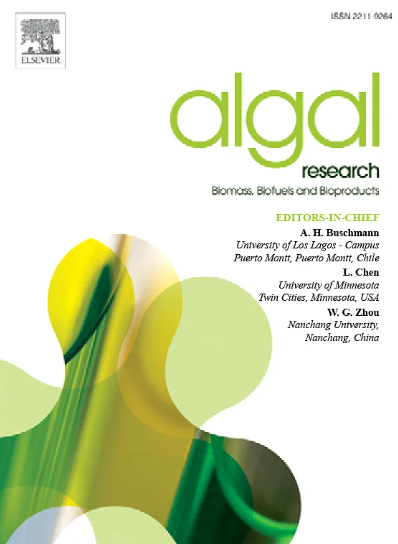Characterization of allelochemicals from Nitzschia closterium and their allelopathic effects on Prorocentrum donghaiense
IF 4.6
2区 生物学
Q1 BIOTECHNOLOGY & APPLIED MICROBIOLOGY
Algal Research-Biomass Biofuels and Bioproducts
Pub Date : 2025-05-08
DOI:10.1016/j.algal.2025.104085
引用次数: 0
Abstract
This study explores the allelopathic interactions and chemical characterization of the diatom Nitzschia closterium and its impact on the harmful dinoflagellate Prorocentrum donghaiense. Using mixed culture and filtrate culture experiments, the allelochemicals released by N. closterium were shown to inhibit P. donghaiense growth in a concentration-dependent manner. These inhibitory effects were linked to disruptions in photosystem II efficiency. In addition, extracts from liquid-liquid extraction (LLE) including solvent of ethyl acetate, n-hexane, petroleum ether, dichloromethane and DMSO, and solid phase extraction (SPE) of filtrate of N. closterium cultures, were tested for their effects on P. donghaiense. Among these, only the n-hexane extracts from LLE significantly reduced algal growth, achieving a 78.1 % inhibition at the highest concentration (50 μL). Fractionation of the n-hexane extracts via HPLC yielded twelve fractions, with fraction F-IV showing the most potent inhibition. Further GC–MS analysis identified several compounds, especially of 3-acetoxy-7,8-epoxylanostan-11-ol, as a key allelopathic agent. These findings contribute to understand the ecological role of allelopathy in regulating harmful algal blooms and highlight the potential of N. closterium extracts for environmental management application.
血吸虫化感物质的鉴定及其对东海原心菌的化感作用
本研究探讨了硅藻Nitzschia closterium的化感作用、化学特性及其对有害藻东海原鞭毛藻的影响。通过混合培养和滤液培养实验,发现梭状芽孢杆菌释放的化感物质对东海海螺生长的抑制作用呈浓度依赖性。这些抑制作用与光系统II效率的破坏有关。以乙酸乙酯、正己烷、石油醚、二氯甲烷、二甲二甲醚为溶剂,采用液-液萃取法(LLE)和固相萃取法(SPE)对东海海螺进行了抑菌效果试验。其中,只有LLE的正己烷提取物能显著抑制藻类生长,在最高浓度(50 μL)下,抑制率达到78.1%。正己烷萃取物经高效液相色谱分离得到12个组分,其中F-IV组分抑制作用最强。进一步的气相色谱-质谱分析确定了几个化合物,特别是3-乙酰氧基-7,8-环氧烷-11-醇是主要的化感剂。这些发现有助于了解化感作用在调节有害藻华中的生态作用,并突出了梭菌提取物在环境管理中的应用潜力。
本文章由计算机程序翻译,如有差异,请以英文原文为准。
求助全文
约1分钟内获得全文
求助全文
来源期刊

Algal Research-Biomass Biofuels and Bioproducts
BIOTECHNOLOGY & APPLIED MICROBIOLOGY-
CiteScore
9.40
自引率
7.80%
发文量
332
期刊介绍:
Algal Research is an international phycology journal covering all areas of emerging technologies in algae biology, biomass production, cultivation, harvesting, extraction, bioproducts, biorefinery, engineering, and econometrics. Algae is defined to include cyanobacteria, microalgae, and protists and symbionts of interest in biotechnology. The journal publishes original research and reviews for the following scope: algal biology, including but not exclusive to: phylogeny, biodiversity, molecular traits, metabolic regulation, and genetic engineering, algal cultivation, e.g. phototrophic systems, heterotrophic systems, and mixotrophic systems, algal harvesting and extraction systems, biotechnology to convert algal biomass and components into biofuels and bioproducts, e.g., nutraceuticals, pharmaceuticals, animal feed, plastics, etc. algal products and their economic assessment
 求助内容:
求助内容: 应助结果提醒方式:
应助结果提醒方式:


